Open Access Presentation
I presented on the state of open access in academic libraries. These are my slides with a transcript of the presentation. This was originally written for my Technical Services class in the Fall of 2017.
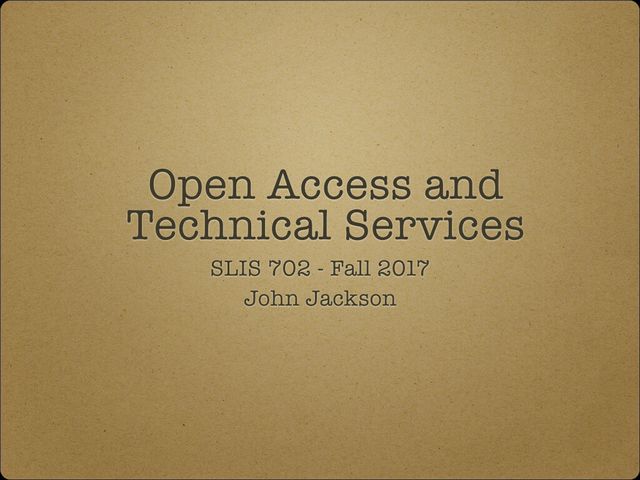
Hello SLIS 702. This John Jackson, and I’m here to present an analysis of open access publishing, specifically how it intersects with technical services in academic libraries. I quote from several articles throughout this slideshow. All of the references will be available at the end.
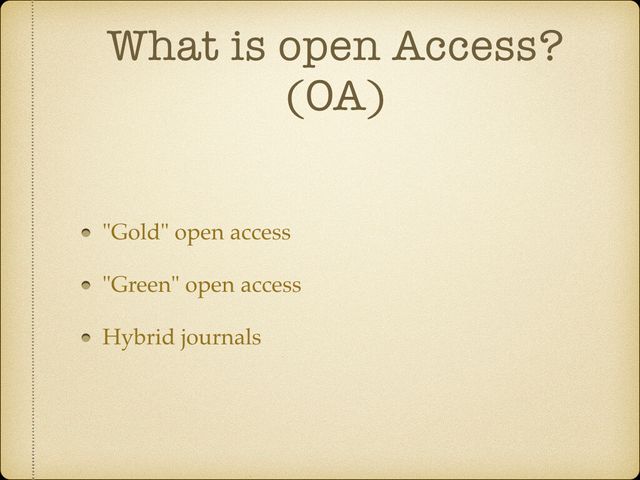
Let’s start with some definitions. First of all, what is “open access?” Or, “OA” for short. While I’m sure everyone is familiar with the academic publishing model, let’s recap. Scholars write articles, publishers put them in journals, and libraries buy them. The problem today is that there are just too many journals and they cost too much. Libraries can’t afford to subscribe to every single one, and budget cuts force them to discontinue their access. Important research is being locked behind prohibitive paywalls and strict copyright licenses.
This problem becomes even starker when contrasted with the trend that information has taken outside of academia. The internet has made information cheaper and more accessible than ever. In a world where Wikipedia can exist, a massive encyclopedia that aspires to contain all human knowledge for anyone to access for free, why is important academic research being blocked behind rising prices and stricter restrictions?
So this is where open access comes in. When a scholar publishes under an OA model, their work becomes publicly available online, for free, for everyone. But it’s not that simple. There are a few flavors of OA. Biggest two are “gold” and “green.” Gold is when the publisher puts their articles out for free. Green is when the publisher charges for the articles, but the scholar is free to put their own copy online. That could either be their own website or a school’s institutional repository. One complication with green is that the scholar sometimes can just use their preprint copy, the one without the journal’s copyeditors or peer review changes. There is also typically an embargo period, such as six months, before the scholar may make their copy available. There are also hybrid journals, that allow some articles to have open access, but not others.
The ongoing problem that hasn’t been completely solved, is how to pay for publishing but maintain its quality. Because OA journals don’t have income from subscribers, they often require the scholars themselves to pay an article processing charge, or an APC, which can be anything from fifty dollars to thousands of dollars. Some researchers have funding to pay these charges, but not all of them do.

What does this have to do with the library? There are a few reasons why libraries need to take open access very seriously. First, it’s in every library’s mission to increase access to materials, which aligns with the open access movement. Second, the number of OA articles is only growing, and if libraries don’t integrate them into their services, them users will find the articles elsewhere. As you can see in the quotes from the literature here, OA is still a niche subject when teaching students research. Combined with that, most students typically go to Google Scholar first when conducting research, which crawls OA journals. Libraries must decide if we’re happy with Google being the de-facto tool for finding OA articles, or if we want to take it upon ourselves to integrate OA into our search tools, and if we want to train students and researchers to know how to find OA articles.
The third reason for libraries to be involved in OA is that libraries are typically the departments that run institutional repositories. As Lana’s article quoted here says, every institution’s motivation for creating a repository is a little bit different. But no matter the situations, establishing and maintaining a successful repository requires not only solid technical service skill, but knowledge of how OA repositories work, how to manage copyright, what scholars expect, and what policies are effective.
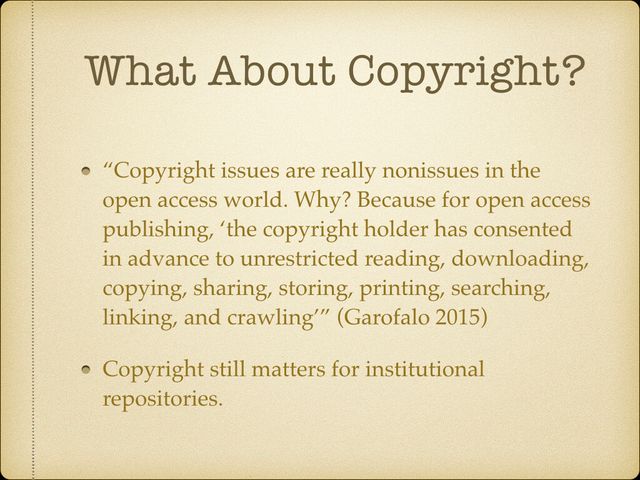
Before we get too deep into open access, let’s take a look at how it effects copyright. One one hand, it can greatly simplify copyright issues. When an article gets published as OA, then copyright almost becomes a nonissue, as Garofalo notes in his article here. Anyone can download or distribute an OA published work.
But for those on the technical service end, copyright is still a looming factor that can’t be ignored. When it comes to managing an institution’s repository, staff must be vigilant about monitoring the rights of their articles. If a researcher submits one of their own works, the library must ensure that they can exercise its copyright. If this is not followed, the school may find itself inadvertently publishing something that violates a publisher’s copyright. Furthermore, the library must account for situations such as: what if the faculty member moves to a new institution? Can we keep their articles? Different schools handle these cases differently.
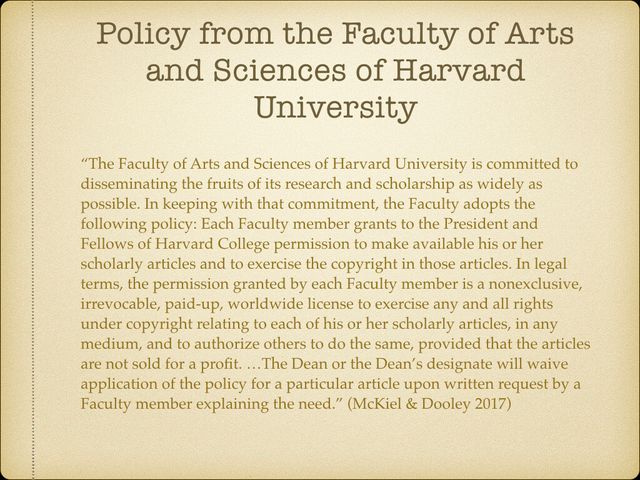
Because running an institutional repository is one of the biggest responsibilities of a library in regards to open access, let’s take a closer look at that.
What I have on this slide is what a lot of librarians call the “Harvard policy.” It’s become sort of a de-facto standard for repository policies. Now, we don’t need to read every word of it right now, but I’d like to summarize the main idea. Basically, it requires all faculty to submit their articles to Harvard’s repository, and gives Harvard permission to exercise the copyright. It’s also strong because it’s an “opt-out” model. If a faculty member cannot submit their work due to a publisher agreement or other issue, they have to make a written request for a waiver that explains their situation. Unless they get the waiver approved, then they must submit to the repository.
This policy is important, because a lot of schools use it as a model when crafting their own institutional repository policies.
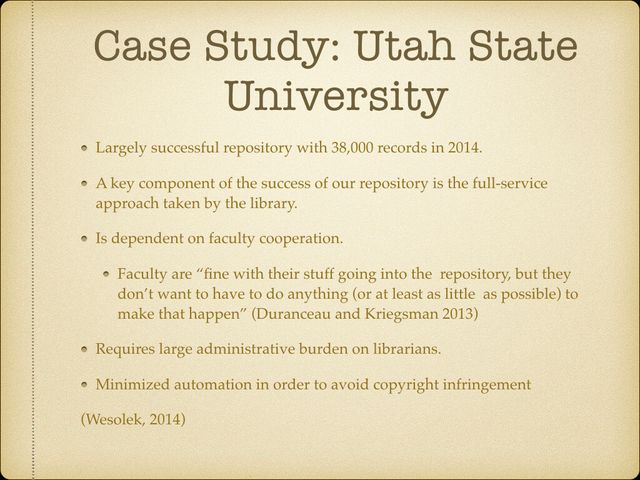
Let’s look at Utah State University. A few years ago, they began working on a repository that’s become largely successful. They have a few qualities that they say contribute to that success. First, they took a “full service” approach. All the faculty were required to do was just turn in their articles, and the library staff took care of the rest. What they found was the most faculty were fine with their articles going into the repository, but the faculty didn’t want to do any work themselves. The downside to this setup was that the work was time-consuming for library staff.
One important observation in Wesolek’s article about this is that almost the entire process could be automated, but that’s not advisable. Without a human to assess each article, then the possibility for copyright infringement is high. They still stored copyrighted articles, but did not make them publicly available.

Our second case study of Allegheny College looks similar to our last. Their repository began initially as a place for historical documents or senior projects to live, but it evolved over time. Their first policy for faculty was what they called and “encouragement pledge,” which is probably the weakest type of policy. As the name suggests, faculty are just encouraged to submit. In the end, they moved to a “Harvard style” policy. One thing that they chose was not to specify which version of the article to use, either the final publisher copy or the preprint. Faculty can submit whichever is best for them. The library here also put a great effort into technology, especially making metadata for the items discoverable by search engines.

My particular interest in academic libraries is in literature and the humanities. So I would like to take a look at how these fields intersect with open access. Currently, researchers in the humanities and social sciences, or HSS, have been much slower to adopt OA models, or even have been resistant to them, compared to other sciences. There are several reasons for this.
First, the OA model does not benefit HSS researchers the same way it does others. Their research is under less pressure to be shared publicly. Also, monograph publishing is much more important to HSS researchers than it is to other science researchers. The current OA systems have almost no effect on monographs.
According to survey studies cited by Ojennus here, there may be more personal reasons as well against using OA. These researchers often feel pressured to publish in journals that carry a certain prestige in an effort to bolster their careers. Many gold OA journals are seen as equivalent to a “vanity press.”
But of course, the bottom line comes down to money. HSS researchers are usually not using public grants the same way that other science researchers are. Article processing charges are out of reach, since they would have to pay these themselves.
In these situations, a green repository, such as one run by the library, would be a great way to get these HSS articles into the OA world.
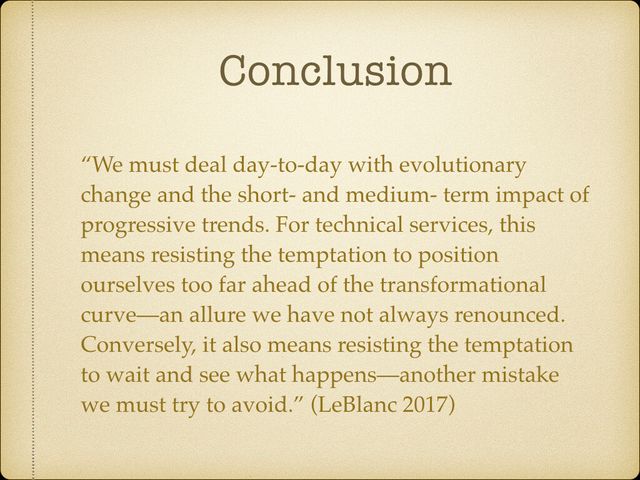
And I would like to close with this quote I found, which I believe encapsulates a wise attitude towards open access, or any other emerging and evolving trend. Every library’s reason for approaching OA is different, but we can all learn from each other. Although it’s prudent to avoid investing too heavily in unproven technologies, if you just wait and see what happens, you may be left behind.
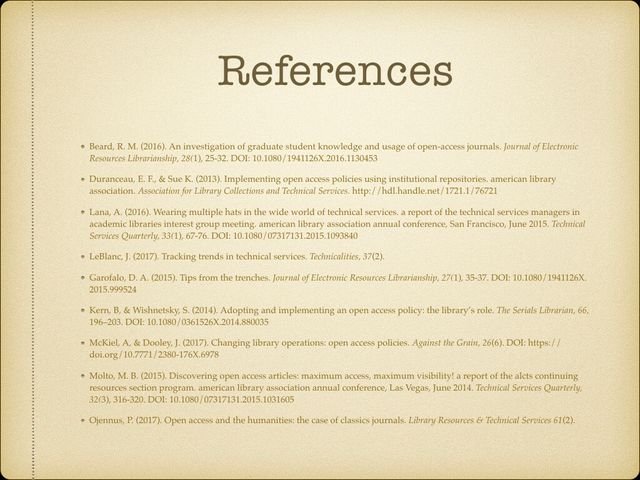
Thank you for watching my presentation. A PDF of these slides are available on Blackboard. It’s been a great semester working with you all.
References
- Beard, R. M. (2016). An investigation of graduate student knowledge and usage of open-access journals. Journal of Electronic Resources Librarianship, 28(1), 25-32. DOI: 10.1080/1941126X.2016.1130453
- Duranceau, E. F., & Sue K. (2013). Implementing open access policies using institutional repositories. american library association. Association for Library Collections and Technical Services. http://hdl.handle.net/1721.1/76721
- Lana, A. (2016). Wearing multiple hats in the wide world of technical services. a report of the technical services managers in academic libraries interest group meeting. american library association annual conference, San Francisco, June 2015. Technical Services Quarterly, 33(1), 67-76. DOI: 10.1080/07317131.2015.1093840
- LeBlanc, J. (2017). Tracking trends in technical services. Technicalities, 37(2).
- Garofalo, D. A. (2015). Tips from the trenches. Journal of Electronic Resources Librarianship, 27(1), 35-37. DOI: 10.1080/1941126X.2015.999524
- Kern, B, & Wishnetsky, S. (2014). Adopting and implementing an open access policy: the library’s role. The Serials Librarian, 66, 196–203. DOI: 10.1080/0361526X.2014.880035
- McKiel, A, & Dooley, J. (2017). Changing library operations: open access policies. Against the Grain, 26(6). DOI: https://doi.org/10.7771/2380-176X.6978
- Molto, M. B. (2015). Discovering open access articles: maximum access, maximum visibility! a report of the alcts continuing resources section program. american library association annual conference, Las Vegas, June
- Technical Services Quarterly, 32(3), 316-320. DOI: 10.1080/07317131.2015.1031605
- Ojennus, P. (2017). Open access and the humanities: the case of classics journals. Library Resources & Technical Services 61(2).
- Wesolek, A. (2014). Bridging the gap between digital measures and digital commons in support of open access: or, how i learned to stop worrying and love human mediation. Collection Management, 39(1), 32-42. DOI: 10.1080/01462679.2014.860856